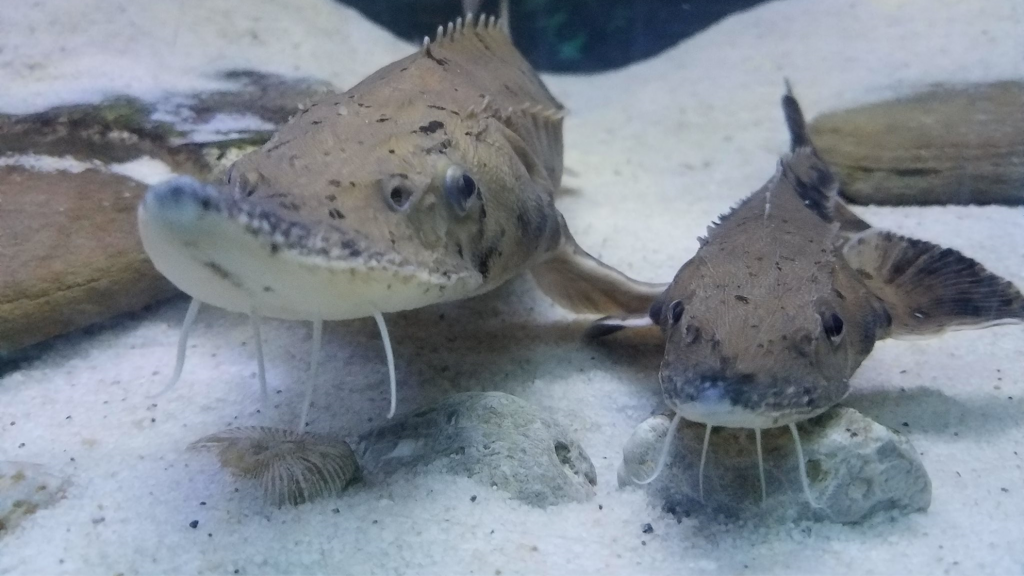Did You Know There Are 150 Year Old Fish Swimming Around The Great Lakes?
Sturgeon have existed virtually unchanged for 200 million years and can grow to be up to 8 feet long. A local expert talks about the role of the ancient megafish in the Great Lakes.

While the nation’s political anxiety has arguably never been higher, it may provide some respite to remember that regardless of the political climate, the natural world continues to carry on around us.
Take, for example, sturgeon which live in and around metro Detroit waterways. Jeremy Guc, Vice President of St. Clair Detroit River Sturgeon For Tomorrow, elaborates on this prehistoric fish.
Watch “Sturgeon Stories,” hosted by the Belle Isle Conservancy, WDET’s Annamarie Sysling and Sandra Svoboda, Program Director of Great Lakes Now:

The Great Lakes Sturgeon can grow up to 8 feet long and easily live up to 150 years old. Guc says that aside from being the largest fish in the Great Lakes, the sturgeon species is also the most prehistoric. “Sturgeon as a species have been around for almost 200 million years basically,” says Guc.
The Giant of the Great Lakes
Guc says the Lake Sturgeon is the species native to the Great Lakes but that they aren’t as plentiful as they once were. “Population estimates put them at about 1% of their historic populations, so not nearly as many today as there were a couple of hundred years ago,” says Guc. He explains that the reasons for that population loss are unfortunately the typical ones, pointing to issues including commercial fishing, overharvest at the turn of the century, habitat degradation and poor water quality.
“I think people would find it hard to believe that just right outside the Riverwalk in Downtown Detroit in the water, there are fish that are 6 and 7 feet long…you don’t see them so you don’t know about them.” — Jeremy Guc, Vice President of the St. Clair Detroit River Chapter of Sturgeon For Tomorrow
While you definitely don’t have to be an angler to appreciate these aquatic giants, if you are someone who’s interested in trying to catch a Lake Sturgeon, Guc says they are hearty enough to tolerate the catch and release method. “[Michigan] DNR records show that there any many fish that are tagged… and there have been many fish that have been caught multiple times over a couple of decades,” says Guc. He says in this way, the fish are unique as three generations of anglers can all potentially catch the same fish. Guc also notes that many members of his group, Sturgeon For Tomorrow, are anglers who were attracted to the group as a way to preserve and protect the fish species.

Bringing Sturgeon from Streams to Schools
The main objective of Sturgeon For Tomorrow, according to Guc, is to perpetuate Lake Sturgeon. “These fish have been here a long time and we want to make sure that they’re here for a long time to come,” says Guc. He explains that the group tries to carry out their mission by promoting public education both in schools to to the general public.
The group also has several outreach programs, including “Sturgeon In the Classroom.” Guc describes it as “a program where every year we pick a few schools to actually raise a juvenile Lake Sturgeon in their classroom for the school year.” He says the program is typically integrated into schools’ science curriculums as students are able to study the growth rates and observe the habits of the fish throughout the school year and then releasing the fish into the wild at the end of the year.
Like most things this year, the program was affected by COVID. Guc cites the uncertainty with the pandemic and school schedules as the primary reason, however, he says that his group still has three juvenile Lake Sturgeon they received from the State Department of Natural Resources. “We plan that they are going to be used for various outreach activities in remote environments after the first of the year,” says Guc.
What’s the Coolest Thing About Sturgeon?
Guc says one of the more unique things about these fish are how long they’ve been around, and that they have been virtually unchanged for 200 million years. “That’s super cool to think that when there were Tyrannosaurus Rexes walking around on earth there were fish that look just like today’s sturgeon swimming around in the water,” says Guc.
He also notes their individual lifespans can be pretty mind-boggling: “These fish can live 150 or more years, so when you think about it, there are fish swimming around in the Great Lakes that were undoubtedly swimming around in the Great Lakes right around the time of the Civil War.”
Trusted, accurate, up-to-date
WDET is here to keep you informed on essential information, news and resources related to COVID-19.
This is a stressful, insecure time for many. So it’s more important than ever for you, our listeners and readers, who are able to donate to keep supporting WDET’s mission. Please make a gift today.
